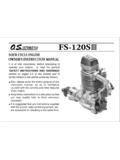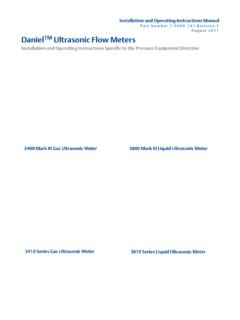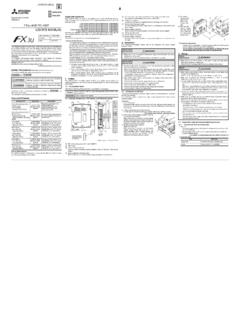Transcription of The improved and complete Instruction Manual for ...
1 The improved and complete Instruction Manual for installing TurnaSure . DIRECT TENSION INDICATORS. (BS 7644). with HIGH STRENGTH FRICTION GRIP. BOLTS (BS 4395 Part 1 and Part 2).. TurnaSure LLC. 2011 TurnaSure LLC. All Rights Reserved. TABLE OF CONTENTS. Introduction .. 1. Theory of High Strength Friction Grip Bolting .. 2. Direct Tension Indicators (DTIs).. 3. Bolt Tensioning Using Self Colour 6. Bolt Tensioning Using Coated DTIs .. 9. Recommended Bolt Installation 12. Problems Commonly Encountered When Tensioning Bolts .. 14. Tool Selection and Performance .. 15. Checking for Specification 16. DTI Identification Markings .. 19.. TurnaSure LLC (July 2006 edition). International Headquarters Phone: 215-750-1300. 340 E. Maple Avenue, Suite 305 Fax: 215-750-6300. Langhorne, PA 19047 Website: 2011 TurnaSure LLC.
2 All Rights Reserved. INTRODUCTION. High Strength Friction Grip (HSFG) bolts are well established as economical and efficient devices for connecting structural steel. The basic rules for their use are laid out in BS 4604 and BS 5950, by The Steel Construction Institute (SCI) and the British Constructional Steelwork Association (BCSA), and the developing European Structural Standards. Designers and inspectors are thoroughly famil- iar with these relevant specifications. Since they originated in 1962, Load Indicator Washers, now commonly known as Direct Tension Indicators (DTIs), have been rec- ognized by many engineers as the most reliable method for ensuring correct installation of HSFG bolts. TurnaSure LLC now introduces a new and improved DTI design, the TurnaSure DTI, which equals and substantially exceeds the requirements of BS 7644.
3 This new DTI has increased the popularity of DTIs in America where applications include bridges in most states, the world's tallest buildings, stadiums, refineries and other industrial and military structures. This Manual is written for Engineers, Supervisors, Inspectors and Erection Staff, to assist them in the proper installation of HSFG. bolts using these new and improved DTIs. This will ensure that bolts have been tensioned to the values required in friction grip connec- tions. The handbook discusses the theory of friction grip connections, proper installation of DTIs, general rules for bolt installation, problems typically encountered when installing HSFG bolts and many other subjects relative to HSFG bolting. TurnaSure LLC has decades of DTI manufacturing experience and provides a range of consultation activity including seminars, site visits, tool recommendations, and specification commentary.
4 1. METRIC. 2011 TurnaSure LLC. All Rights Reserved. THEORY OF HIGH STRENGTH FRICTION GRIP BOLTING. The principle of HSFG bolted connections relies upon tension- ing each bolt in the connection to a specified minimum tension so that the desired clamping force will be induced in the connection inter- face. Shear loads are then transferred by frictional resistance at the joint interface rather than by bearing on the bolt shanks and hole faces. In this type of connection there will be no movement of the con- nected materials when the connection is subjected to these loads. Movement in many types of joints is highly undesirable, hence the development of the friction grip connection. (Figure 1). Figure 1. When tension loads are applied in the direction of the bolt axis, tensioning to a specified minimum tension is also important, partic- ularly if the loads are cyclical and could induce loosening or fatigue failure of the bolts.
5 The clamping force at the specified minimum ten- sion should be greater than the applied loads. This will prevent the plies from separating or the bolts from developing any significant increase in tension stress over the installed pretension stress. (Figure 2). Figure 2. 2. METRIC. 2011 TurnaSure LLC. All Rights Reserved. DIRECT TENSION INDICATORS (DTIs). Only TurnaSure Direct Tension Indicators (DTIs) are covered under British, American, and other worldwide patents. They are even more accurate than earlier designs, and are very simple devices to use for ensuring that bolts have been installed above the specified minimum tension values. Used properly they positively ensure the correct amount of clamping force. Readers who have installed HSFG bolts using torque/tension values will notice that this Manual does not relate torque to tension.
6 Torque, or twisting force, is not a reliable measure of bolt tension. DTIs measure tension regardless of applied torque. The TurnaSure DTI is washer-shaped with protrusions, bumps, pressed out on one face, manufactured to exceed the provi- sions of BS 7644. The fact that it resembles a washer is incidental. It is, in fact, a precision made mechanical load cell; a device for ten- sioning HSFG bolts, which is not only covered by the British Standard but also by a tightly controlled American Standard ASTM F959M-05. When a DTI is installed on a bolt with the bumps placed against the underside of the bolt head there are noticeable gaps between the bumps. As the nut is turned and the bolt tensioned, the bumps flat- ten. When the bumps are flattened so that the gaps have been reduced to the required dimension, the bolt has been properly ten- sioned and required clamping force is present.
7 A DTI does not make it more difficult to tension a bolt, it merely shows that the bolt has been properly tensioned. (Figure 3). Figure 3. 3. METRIC. 2011 TurnaSure LLC. All Rights Reserved. Direct Tension Indicators are supplied either self colour that is without a coating, or Sherardized to BS 4921 1988, or mechanically galvanized to BS 7371 (Part 7) or ASTM B695 (Class 50) as appro- priate. They are also produced from weathering steel for use with bolts to BS 4395 made from heat treatable grade weathering steel. This is limited to Part 1 General Grade bolts only. Other coatings may be available upon enquiry. DTIs are usually installed under the bolt head and the nut turned. When the bolt is properly tensioned the gap will be less than in more than half of the spaces. If installed under the ele- ment turned, the nut, then a.
8 25MM feeler gauge is used. For BS. 4395 Part 2 HSFG Bolts and Nuts a .50MM or a .35MM (for under nut) feeler gauge is sometimes used as the maximum average, and if desired a .40MM or a .25MM as the minimum average gaps. Coated DTIs are installed using a criteria. To assure that the DTI is properly installed, feeler gages, and thick, can be provided with DTI shipments. To ensure that the DTI is properly compressed, and the bolt tensioned, the appropriate feeler gage must be refused in a given number of gaps between the bumps. It must be emphasized that especially with these newly designed DTIs zero gap should not be cause for rejection. (Table I. lists the number of bumps for each size and grade of DTI and the required number of gage refusals in the gaps.). Table 1. Bolt Grade 1 ( ) Grade 2 ( ). Size Bumps Refusals Bumps Refusals M12 4 3.
9 M16 4 3 4 3. M20 5 3 5 3. M22 5 3 6 4. M24 6 4 7 4. M27 6 4 7 4. M30 7 4 8 5. M33 8 5. M36 8 5 . 4. METRIC. 2011 TurnaSure LLC. All Rights Reserved. For coated DTIs M-22 (or when assembled For self colour under turned elements). H1. 2. mm mm Figure 4. When inserted the feeler gage must be pointed at the center of the bolt and be at the center of the space. Notches in the of the redesigned DTIs assist in feeler gage inspection as the notch corresponds to and is in alignment with each feeler gauging space. (Figure 4). Usually, erection staff develop a feel for installation and can install DTIs to the correct gap by eye. Inspectors will want to verify that the correct gap has been achieved using a feeler gage on a lim- ited number of DTIs and then compare other gaps by eye. Fully com- pressed DTIs should not be rejected.
10 Some inspectors judge that a bolt which has fully compressed a DTI is over tensioned . Much experience has not identified a problem of over tensioning particu- larly with Part 1 HSFG bolts. Many experts believe that unless a tensioned bolt has broken it is acceptable. Further support for this recommendation can be found in a report published in Volume 36, No. 1 of the Engineering Journal, (Published by the American Institute of Steel Construction, or AISC) entitled The Effects of Over- Compressing ASTM F959 Direct Tension indicators on A325 Bolts Used in Shear Connections . This is Available from your TurnaSure distributor. 5. METRIC. 2011 TurnaSure LLC. All Rights Reserved. BOLT TENSIONING USING SELF COLOUR DTIs METHOD #1 (PREFERRED METHOD). DTI Under the Bolt Head Turn the Nut to Tension This method should be used whenever possible as it ensures that the bolt has not been trapped by movement of the steel plies before tightening.






